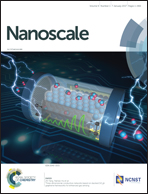Regioselective plasmonic nano-assemblies for bimodal sub-femtomolar dopamine detection†
Abstract
Reliable and ultrasensitive quantification of dopamine (DA) is essential in the precise diagnotherapy of neurological diseases. In this study, dual mode counterpropagating-responsive gold@silver nanoparticle–gold nanorod (Au@AgNP–AuNR) nano-assemblies were fabricated for the precise quantification of DA. The plasmonic Au@AgNP–AuNR assemblies possessed high surface-enhanced Raman scattering (SERS) activity and strong fluorescence quenching, due to the prominent electromagnetic enhancement between the hotspots of the assemblies. In the presence of a DA target, the Au@AgNP–AuNR assemblies dissociated, leading to an increase in fluorescence intensity and a decrease in SERS intensity. The limit of detection (LOD) of DA was 0.04 fM and 0.02 fM by the fluorescence method and SERS method, respectively. The linear range was 0.1–10 fM. These findings demonstrated that the simultaneous positive fluorescence response and negative SERS response ensured the accurate detection of DA, which opens up a new avenue for the early diagnotherapy of neurological diseases.



 Please wait while we load your content...
Please wait while we load your content...